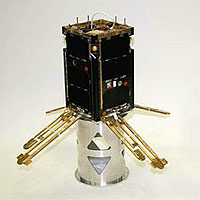Solar & Battery Fan DIY STEM Kit
$9.99$5.95
Posted on: May 15, 2012

Completed cubesat at Utah State University in the DICE cubesat project.
Credit: Utah State University
Imagine a fully instrumented satellite the size of a half-gallon milk carton.
Small low-cost satellite payloads, built mainly by students and hitching rides into orbit on Air Force and NASA launch vehicles, have been making recent history in successes many herald as a 'space revolution.'
Called cubesats for the roughly four-inch-cubed dimensions of their basic building elements, each one is stacked with modern, smart-phone-like electronics and tiny scientific instruments.
Several cubesat projects funded by the National Science Foundation (NSF) are currently operating in orbit, making first-of-their-kind experiments in space and providing new measurements that help scientists understand how the Earth's upper atmosphere responds to solar activity.
And more are on the way.
Several other payloads are already built and awaiting launch this summer with their host spacecraft. Yet others are in the process of being constructed or designed, all poised to provide new scientific measurements to answer questions in space and atmospheric science.
But this is just the beginning, say scientists.
The future of cubesat projects is only limited by the imagination, researchers believe. The capabilities of cubesat systems are growing at an ever-increasing rate as technological advances are made.
Opportunities are many to accelerate this technology through engineering research in an array of fields, including materials research, 3-D printing, sensor miniaturization, micro-electro-mechanical systems, systems engineering, radio science, communication algorithms and networks.
Private firms and government agencies are also adopting the cubesat concept as a low-cost way of flying payloads in space while creating important educational opportunities for future leaders of industry.
The projects stimulate widespread excitement and involve a unique set of skills and interests. They appeal, say researchers, to a broader range of participants than more traditional science and engineering projects.
What will it take for future cubesat projects to provide the crucial measurements from space needed to solve critical societal problems, such as climate change, land use and resource management, pollution and disaster monitoring, communication and space weather?
On May 24, NSF will host an event titled: 'Workshop to Explore the Utility of Cubesat Projects for Scientific Research and Technology Advances and STEM Education and Workforce Development.'
Scientists, engineers and educators will showcase their current NSF-funded cubesat science and engineering projects.
Presentations will explore the potential for cubesat projects to play a major role in solving critical societal problems and enabling scientific discoveries and engineering innovation.
The event will feature posters and exhibits presented by the project teams, as well as presentations highlighting current and future cubesat capabilities.
Who: Cubesat project scientists, engineers, educators and students
What: Workshop to Explore the Utility of Cubesat Projects for Scientific Research and Technology Advances, and STEM Education and Workforce Development
When: Thursday, May 24, 2012, noon to 3:00 p.m. ET
Where: National Science Foundation Atrium, 4201 Wilson Blvd., Arlington, VA 22230
Detailed Agenda:
Organizers:
Therese Moretto Jorgensen, NSF program director for Space Weather Research and Instrumentation in the Geosciences Division of Geospace and Atmospheric Sciences
Rathindra DasGupta, NSF program director for Industry/University Cooperative Research Centers in the Engineering Division of Industrial Innovation and Partnerships
Kevin Simmons, Senior Policy Analyst in the Engineering Division of Industrial Innovation and Partnerships
Schedule:
Noon to 3 p.m.--Posters and exhibits are staffed
1 p.m to 3 p.m.--Presentations:
Michael Morgan, NSF Division Director for Geospace and Atmospheric Sciences--Welcome and introduction
Jordi Puig-Suari, California Polytechnic (to be confirmed)--Cubesats as a disruptive technology
James Cutler, University of Michigan--Experiences with student-built cubesats
Norman Fitz-Coy, University of Florida--Utility of cubesat data to developing countries, especially those in Africa, for addressing socio-economic needs
Eloisa de Castro, Princeton Satellite Systems, Inc.--Industry involvement in cubesats and education.
 'To myself I seem to have been only like a boy playing on the seashore, and diverting myself in now and then finding a smoother pebble or a prettier shell than ordinary, whilst the great ocean of truth lay all undiscovered before me.'
'To myself I seem to have been only like a boy playing on the seashore, and diverting myself in now and then finding a smoother pebble or a prettier shell than ordinary, whilst the great ocean of truth lay all undiscovered before me.'